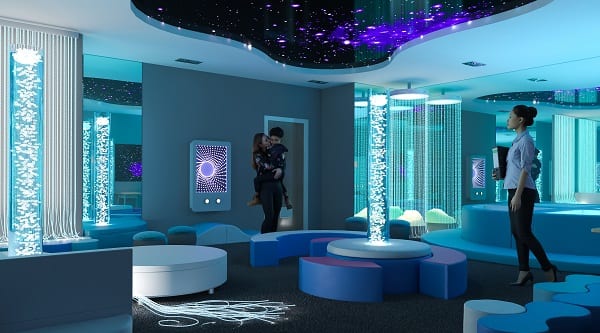 Add My Company
Add My Company
How to Design a Sensory Room?

How to design a sensory room is a question often asked Sensory equipment can range from a corner bubble tube area to fully interactive gesture and touch controlled sensory rooms, so the design can often depend on quite a few other questions, these may be a good starting point to consider before designing your sensory room: 1) Budget you can achieve alot with a small budget, particularly with one our our Sensory Corner Packages. Many Sensory Rooms still have a sensory bubble tube, and we can turn this into a Sensory Corner with fibre optics, acrylic mirrors and a padded corner base in vibrant colours to start your journey into Sensory! Big budgets do allow for larger rooms and more equipment, whether this be mobile sensory equipment, such as our Interactive Floor System or fixed equipment that cannot be removed or tampered with. Bigger budgets allow for differing ‘areas’, such as an interactive corner, a calming area with padded seating, a UV area, or quiet den’s. Typically Starter Rooms range from £2-5K Full Sensory Rooms range from £5k to £10K+ 2) Space Many schools wish to use a room as multi-functional, with classroom space or room for an occupational therapist to use larger Sensory Integration equipment such as swings, rockers, weighted blankets and vestibular equipment. This needs to be considered when designing a sensory room to ensure there is enough space. Sensory at home or within a residential centre, often in individual bedrooms, can be designed to meet the service users sensory needs. Often projectors, sensory corners, and fibre optic rugs are included. This can work around the bedroom equipment. If you have a dedicated room ready to be magically transformed into a sensory room- great! Simply take some measurements and some pictures and fill in our sensory room design form online, and we can create a free 3D drawing and quotation to equip the room. 3) Needs Sometimes wall and floor padding is required, for protection and to prevent injury. This does also look lovely, with a vast array of vinyl colours- however, adding wall padding to a sensory room just to increase the asthetics, is not always the best way to go as it can eat up alot of the budget that could be used with dedicated sensory equipment. Although alot of sensory equipment is still marketed towards the young, we have had vast experience installing and designing sensory rooms for adults and care homes, residential centres and on behalf of councils for use at home. It is a shame most of the photography of sensory equipment still depicts young people, but its use is just as important to teenagers, adults and the elderly. Often involving your OT (if you are a school), will help steer your choices towards what is needed for your child, or a group of special needs children. They may react with delight to stimulating sounds, or to a calm colour changing room with the gentle sound of bubbles. Your room may end up having a good choice of different equipment to stimulate all the senses, and can be used individually. 4) Imagination Designing a sensory room can be alot like interior designing- sometime collaborating with someone can help fine tune what you are looking for. We offer a no obligation 3D design and quotation to help you start your sensory journey. Contact us on info@sensesensory.co.uk or fill in our sensory room design form and we can begin fuelling your imagination with sensory room design ideas!
For more information on How to Design a Sensory Room? talk to Sense Sensory

